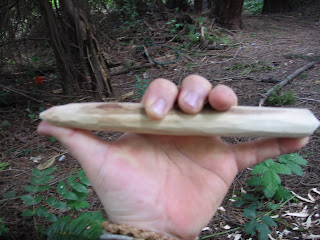"Strive toward perfect part's & form and the bow drill will come with ease & delight."
Parts:
Bow & String-
 The length of the bow should be as long as from your armpit to wrist with a little curve. The bow should be strurdy and a little flexible. The string can be made from natural plant fibers, sinew, rawhide, or any modern string. I have not used natural cordage yet because I need to make a flex bow for that skill. Lets just stick with modern string for the beginner.
The length of the bow should be as long as from your armpit to wrist with a little curve. The bow should be strurdy and a little flexible. The string can be made from natural plant fibers, sinew, rawhide, or any modern string. I have not used natural cordage yet because I need to make a flex bow for that skill. Lets just stick with modern string for the beginner.
Hand Hold
 Find a piece of wood that fits comfortably in your hand. This wood should be the same or harder than the spindle. After the hole is burned, put some soap, fat, or even pitch in the hole to stop the friction.
Find a piece of wood that fits comfortably in your hand. This wood should be the same or harder than the spindle. After the hole is burned, put some soap, fat, or even pitch in the hole to stop the friction.
Spindel
 The hardness of the spindle and the fireboard should be the same. This will allow even wear on both the board and spindle. Spindles should be no bigger than your thumb and should be as long
The hardness of the spindle and the fireboard should be the same. This will allow even wear on both the board and spindle. Spindles should be no bigger than your thumb and should be as long
as from the tip of your pinky to the tip of your
thumb. As you can see in the picture, one side comes to a long point and the other side comes to
a shallow point. This is to control the friction. We want alot of friction where the spindle meets the fireboard so there is a shallow point with more surface area in contact with the board.
Fireboard and Notch
 Fire boards should be thumb thick or less with a
Fire boards should be thumb thick or less with a
flat top and bottom and with squarred off sides. My fireboard here is really just a bit to wide. Fireboards should be two spindles wide. That way I can use both sides without having a bunch of wood in the middle that won't ever be used.
When burning in the hole on the fire board, make sure that the rim of the hole is not quite out to the edge of
the fire board. As you can see the hole was burned until it was the same size as the spindle.
To get the perfect notch we need to carve out 1/8 of the hole. Make sure that the center of the notch is not quite the center of the hole. The walls of the notch should come straight down and b e smooth. If the walls of the notch are not smooth, the dust will have a harder time forming a coal at the bottom.
Some ideas for good tinder: dry grass, mosses, leaves, inner bark, milk weed/cat tail down.
Make sure that your wrist locks into your leg so that the spindle will have support.


A complete set made from just one branch.
















